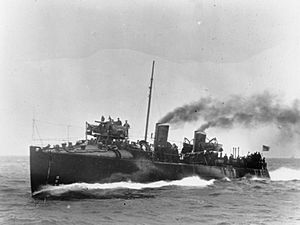HMS Foam (1896) facts for kids

Fame, sister-ship of Foam
|
|
Quick facts for kids History |
|
|---|---|
| Name | Foam |
| Ordered | 10 May 1895 |
| Builder | John I Thornycroft, Chiswick |
| Cost | £54,432 |
| Yard number | 307 |
| Laid down | 16 July 1895 |
| Launched | 8 October 1896 |
| Commissioned | July 1897 |
| Fate | Sold for breaking, 26 May 1914 |
| General characteristics | |
| Class and type | Two funnel, 30 knot destroyer |
| Displacement |
|
| Length | 210 ft (64 m) o/a |
| Beam | 19 ft 6 in (5.94 m) |
| Draught | 5 ft 8 in (1.73 m) |
| Installed power | 5,700 shp (4,300 kW) |
| Propulsion |
|
| Speed | 30 kn (56 km/h) |
| Range |
|
| Complement | 65 officers and men |
| Armament |
|
HMS Foam was a special type of fast warship called a destroyer. It was built for the Royal Navy in the United Kingdom. Foam was known for having two funnels and being able to travel at 30 knots (about 55 kilometers per hour).
This ship spent most of its time serving in the Mediterranean Sea. It was sold in 1914, just a few months before World War I began.
Building a Destroyer: HMS Foam
The Royal Navy ordered Foam on May 10, 1895. Its construction began on July 16, 1895, at the John I Thornycroft and Company shipyard in Chiswick, London. This shipyard was located right on the River Thames.
Foam was officially launched into the water on October 8, 1896. After its launch, the ship went through special tests to make sure it could reach its promised speed of 30 knots. Once these tests were done, it sailed to Portsmouth to have its weapons installed. The Royal Navy officially accepted Foam in July 1897. During its final tests, the ship's average speed at sea was 25 knots (about 46 km/h).
Life Before the War
On June 26, 1897, HMS Foam was part of a big naval parade. This event, called the Royal Naval Review, celebrated Queen Victoria's Diamond Jubilee. It was a huge party for the Queen's 60 years on the throne.
A famous writer named Rudyard Kipling visited Foam in May 1897. He learned a lot about destroyers during his visit. He later used what he learned to write a poem called "The Destroyers."
Later in 1897, Foam was sent to join the Mediterranean Fleet. It stayed there for most of its time in service. In March 1902, Lieutenant Stanley Venn Ellis became the ship's commander. In September 1902, Foam visited Nauplia in Greece with other ships from the fleet. The ship finally returned to British waters in 1913.
In August 1912, the navy decided to give letters to all destroyer classes. Foam was put into the 'D' class because it was a 30-knot ship with two funnels. After September 1913, it was officially called a D-class destroyer. To show this, a large letter 'D' was painted on its hull near the bridge and on one of its funnels.
End of Service
As the Royal Navy updated its ships, Foam was no longer needed. It was sold on May 26, 1914, in Chatham, England. The ship was then taken to Norway to be taken apart for scrap metal.

